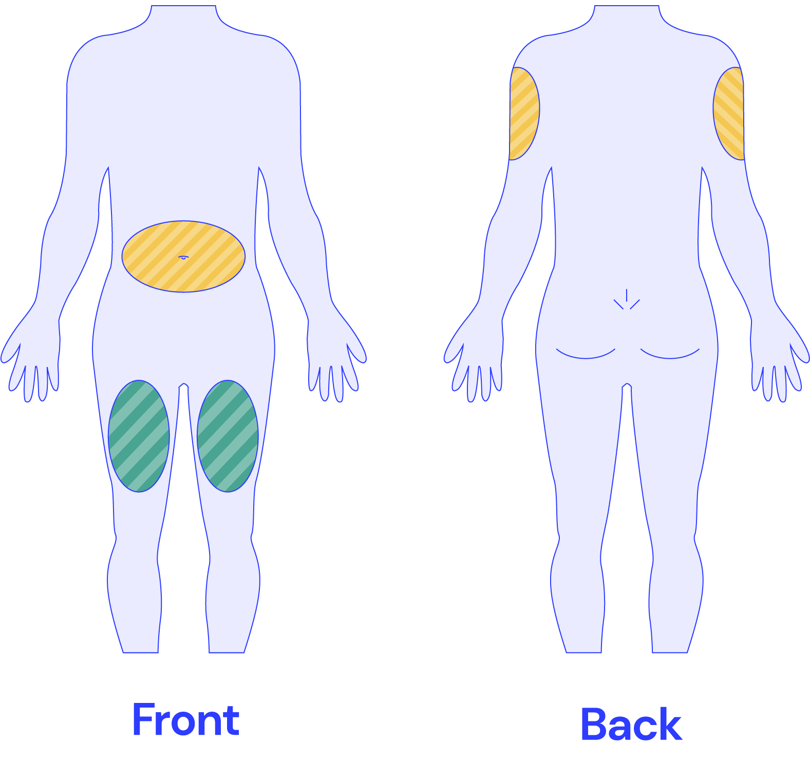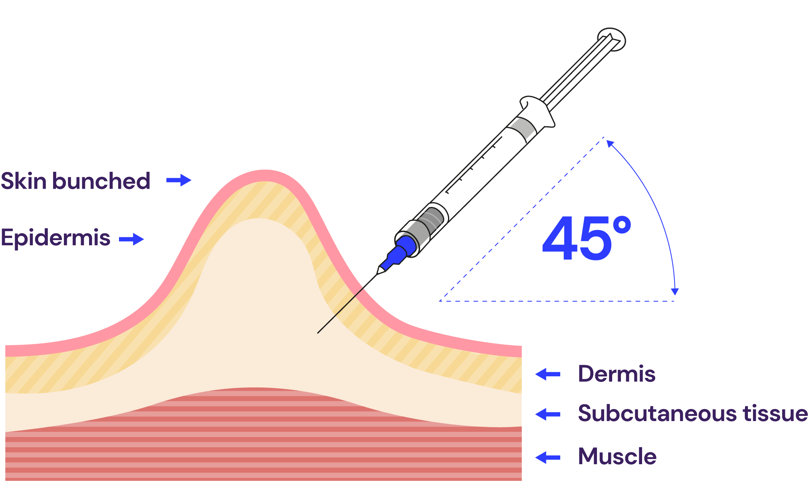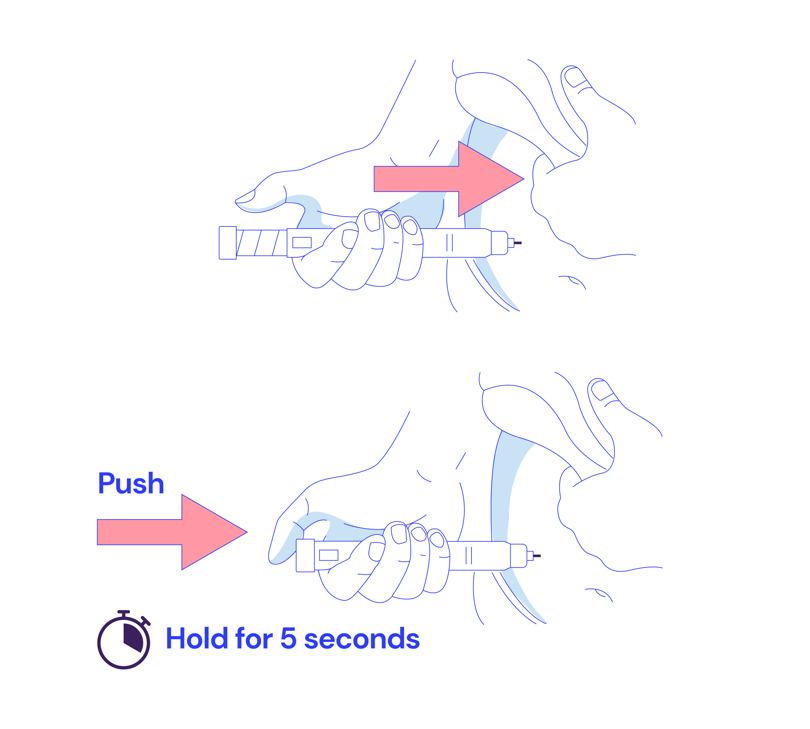Before you inject
- Check the contents of the pen, vial or amp before you draw up or prepare to inject – what you buy may not be what it says on the label. If you see bits in the fluid and it’s meant to be clear, or it is a different colour to what the package leaflet states for example, this could be a sign of contamination and the injection may not be safe to use
- Remember - the ingredients, strength and purity can vary between manufacturers, so even if you take something regularly, unless it is from an approved registered pharmacy, the actual dose may differ from batch to batch
- Rotate the sites you inject into – this gives your body time to heal between injections. Injecting into broken, irritated or lumpy skin can increase your risk of infection. Ideally a site should not be re-used within 4 weeks
Always use the right needle and the right barrel
- Use a new, sterile needle every time – this reduces your risk of injuries and infections
- Stick to your own needles, barrels and pens/vials/amps – using your own equipment can prevent the spread of blood-borne viruses (BBVs) like hep B, hep C and HIV. You can get fresh equipment from any substance use service and many pharmacies
- Pen devices commonly require specifically designed needles which screw onto the device. These are available to purchase from your local pharmacy or various online retailers. They are available in different sizes. Typically an adult would use the 4mm 32g size. Your pharmacist can advise if you are unsure. The package leaflet, which should come with the pen device, will advise of the brand(s) of needles which are compatible
Make sure you’re injecting in the right place
The safest places to SC inject are around the stomach, fatty parts of the arm, and the outer parts of the thigh (see Fig 1. below).

Figure 1. Subcutaneous injection sites
When you’re injecting
Cleaning your injecting site correctly helps to prevent infections.
- Always wash your hands with soap and water before you inject. If you don’t have soap and water, you can use new alcohol swabs, or hand sanitiser gel
- Wash your injecting site with soap and water too, or clean it with a single wipe of an alcohol swab. Use a swiping motion in one direction. Rubbing in a circular or back-and-forth motion can spread dirt and bacteria around
- Allow your skin about a minute to dry before you inject
- If you’re using a multi-dose vial/pen, use a swab to wipe the top of the vial before you draw up from the vial, or attach the needle (if a prefilled pen)
Injecting subcutaneously if injecting from a vial
- Choose the injection site using the chart. You should use a different site each time you inject.
- If drawing up use a green needle, then swap to a fresh needle of the appropriate size for injecting (see above for guidance). This will typically be a 23-27g needle that is between 5/8 and 1/2 in length.
- Some people use insulin syringes with fixed needles for convenience. If you do this make sure you use a new syringe each time you inject.
- Use a 1ml barrel - using larger barrels makes it harder to draw up accurate doses and can result in you taking too much.
- Holding the syringe with the needle upwards, tap the syringe gently to move any air bubbles towards the needle.
- Push the plunger gently to remove any air bubbles and ensure the syringe contains the desired dose.
- Lift the skin in the chosen injection area between your thumb and index finger.
- Holding the needle at a 45° angle as shown in Figure 2, insert the needle into the skin fold.
- Continue to hold the skin and push the syringe plunger to inject the medicine while counting to 10 slowly.
- Remove the needle from the skin and let go of the skin fold.
- Put a piece of cotton wool or gauze over the injection site for a few seconds.
- Dispose of the syringe and needle(s) in a sharps bin.
- Mark the injection site on your site rotation chart so you know not to use this site next time.

Figure 2 - Subcutaneous injection
Injecting subcutaneously if using a pen device
Different types of injecting pens work in different ways. Step by step instructions for how to use your pen should be included in the packaging, or on the manufacturer’s website. You should follow the advice for your specific pen device as these differ between brands.
Even if the drug you are planning to use comes in a pen device, unless it is purchased from a registered healthcare professional or dispensed to you on prescription it may not contain what you are expecting.
Basic guidance for injecting using a pen device
- Choose the injection site using the chart. You should use a different site each time you inject.
- Always use a new needle for each injection - typically an adult would use the 4mm 32g size pen needle. Peel off the paper back of the needle and screw/push this onto the pen device.
- If your device requires you to prime it or use a dial to prepare a dose do this next. Some devices do not require you to prime them - always read the leaflet before you use them.
- Gently pinch the skin and insert the needle at an angle of 90 degrees (a right angle). Please note the angle and method of injection may vary depending on the pen device. You should follow the advice of the manufacturer to administer a dose as this may differ between devices.
- Press the plunger until the dial returns to 0, or the plunger is fully depressed.
- Hold the needle in the skin for 10 seconds after fully pressing the plunger to ensure the full dose has been administered.
- Once you have used a pen injector, remove the needle from the device and dispose of the needle in a sharps bin. If you have used your last dose from the pen and it is not re-useable, dispose of this in a sharps bin too.
Some devices have a small amount of liquid left in the device after the last dose. This can be referred to as the ‘golden dose’, but it is risky to try and extract this as the amount of drug left can vary, and may lead to you taking too much of a drug if you try to extract it. If you choose to use standard needles to extract and administer this additional liquid this increases the risk of causing side effects, skin infections or Blood Borne Viruses (BBVs).

Figure 3 - Subcutaneous injection using a pen device
Visit your local needle and syringe service
Needles and syringe services are free services where users are welcome.
Find a needle and syringe service near you
They’re completely confidential. Staff won’t tell anyone that you’ve been there, including your work or GP.
Some services have specialists in steroids and other image and performance-enhancing drugs (IPEDs). Ask if a specialist is available when you go in.
As well as new needles, barrels, swabs and bins, staff can help with:
- safer injecting advice
- advice on sore or infected injecting sites
- testing for hepatitis C and HIV
- hepatitis B vaccinations
- free condoms and sexual health advice
- disposal bins
What to expect when you visit a needle and syringe service





